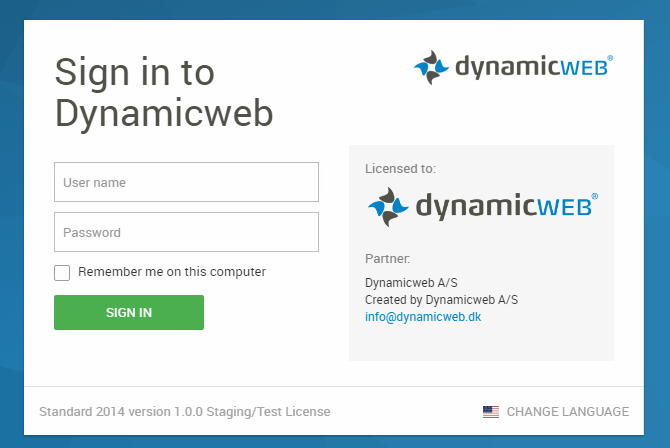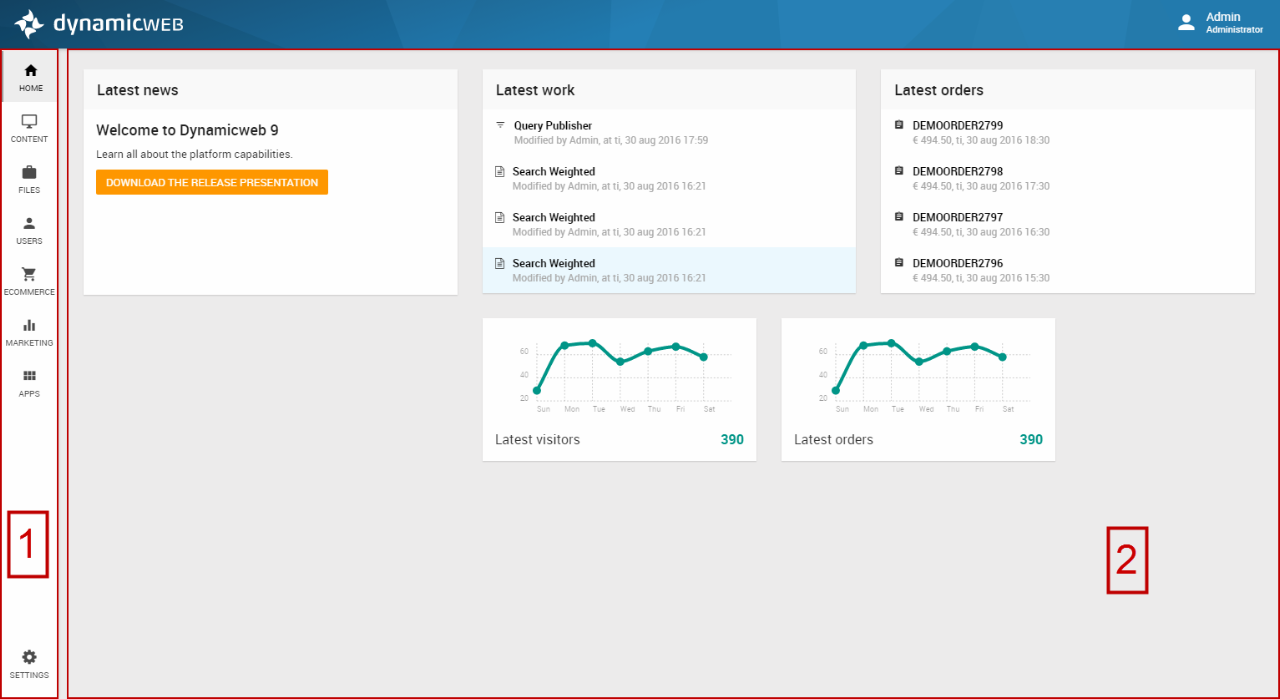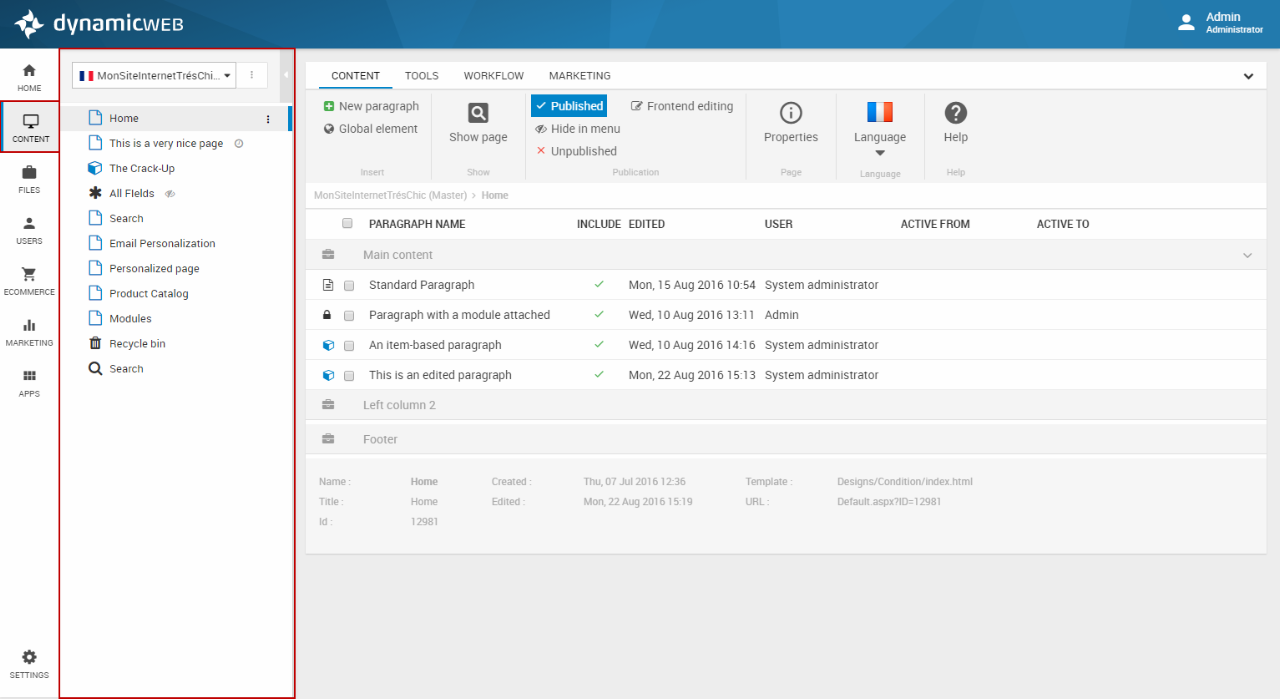Backend & Features
Once you have a Dynamicweb solution installed, you can start using it to do cool stuff.
But first you must learn about the basics:
- Logging in to your solution
- The Dynamicweb backend
- The Dynamicweb features - and where to learn more about them
Login
To get started with your Dynamicweb solution, you must login to the Dynamicweb administration backend:
- Open a web browser of your choice – see the list of supported browsers here
- Enter the URL pointing to your solution followed by /admin – e.g. www.myfancycompany.com/admin
- Enter your username and password in the appropriate fields on the login screen (Figure 2.1)
- Click sign in

The Dynamicweb backend
Once logged in, you will see the Dynamicweb administration interface (Figure 3.1) – also called the backend – which consists of an area menu (1) and a content pane (2).

- The Area menu (1) allows you to navigate between the main areas in Dynamicweb – Content, Files, Ecommerce, Marketing, Modules and Settings. Not all solutions have access to all areas – the specific layout depends on your license type.
- The Content pane (2) shows the workspace or the content of nodes selected in the area trees. In other words, this is where you do most of your work – edit product details, add paragraph content to a paragraph, upload and move files around, etc.
At login, the content pane shows your workspace - a collection of widgets containing useful statistics and shortcuts will make using working in Dynamicweb 9 easier. The workspace screen will continue to see improvements with future releases.
Once you click one of the main areas you will also have access to an area tree (Figure 3.2), in this case the content tree.

The area tree lets you navigate and work with the features associated with the selected main area; when Content is selected the navigation pane shows a content tree from which you create and manage content, and when Ecommerce is selected, the navigation pane shows the Ecommerce tree from which you handle orders, products, RMA and so forth.
Feature overview
Content Management, Ecommerce, Marketing, Users, and Integration – an All-in-One Platform like Dynamicweb can do it all natively.
Which means that it can get a bit overwhelming, at times.
Here’s a short overview of the main features in Dynamicweb – and links to the relevant documentation areas.
Content
A website without content isn’t very useful.
Content in Dynamicweb consists of:
- Pages which define the overall structure for your websites
- Paragraphs which act as containers for content – and may have a module attached to them, e.g. a Product Catalog which publishes Ecommerce products in the frontend, or a Gallery modules, which publishes the contents of an image folder to the frontend
Both pages and paragraphs can be item-based. Items are a flexible and powerful way of generating, managing and presenting content, extending website, user or page properties, and much more.
Read more about working with content in the Content section of the Dynamicweb documentation.
Files
To help you manage the files and folders used on your solution, Dynamicweb ships with an integrated File Manager.
Apart from the standard operations – creating, opening, editing, renaming, moving, copying and deleting files and folders – the file manager has the following features:
- Set meta tags on a folder or subfolder level, and have all files inherit the metadata
- Built-in link management and validation
- Automatic renaming of uploaded files
- Advanced image handling, like rule based resizing of uploaded files
Read more about the File Manager (and other Platform features) in the Platform section of the Dynamicweb documentation.
Users
It doesn’t matter if you’re big or small – all modern web solutions work with users.
Some need to administer only a small group of backend users, others need to handle thousands – or hundreds of thousands – of registered front-end users, customers, editors, and so forth.
- Register and login users using the Extranet module and organize them in user groups
- Set permissions for individual users or user groups – in both frontend and backend
- Use smart searches to create dynamic user groups based on user information, audit data, or even on the behavior of your users on your website or in relation to your email marketing efforts
Read more about working with Users in the Users section of Dynamicweb documentation.
Ecommerce
Dynamicweb Ecommerce is one of the most advanced ecommerce systems on the market, and provides you with a number of powerful tools, options and integration points, to help you deliver the best online shopping experience possible.
With Dynamicweb Ecommerce, you can:
- Use the Product Catalog tools to work with products, product groups, shops
- Use the Orders area and tools to work with orders, quotes, and RMAs
- Use the Payment & Shipping tools to handle payment, vouchers & discounts, VAT & Taxes, shipping – and more
- Use the Internationalization tools to localize – and globalize – your Ecommerce solution, adding the currencies, countries and languages
Read more about using Dynamicweb Ecommerce in the Ecommerce section of the Dynamicweb documentation.
Marketing
The Dynamicweb Marketing tools are a powerful combination of tools, which enable you to create and execute focused and intelligent online marketing strategies.
With Dynamicweb Marketing, you have access to:
- The Leads tool, which helps you identify and act on potential leads
- The Email Marketing tool, which enables you to create and execute intelligent email marketing campaigns
- The Personalization tool, which enables you to profile your visitors and create and show personalized content to them
- The SMS Module, which enables you to send out text messages to groups of users
- The Social Media Publishing module, which enables you to publish content directly to any number Twitter or Facebook accounts
- The Split Test functionality, which allows you to experiment with variant content and measure which version performs the best
Read more about using the Dynamicweb Marketing tools in the Marketing section of the Dynamicweb documentation.
Backend translation policy
Translation of the Dynamicweb back-end user interface to local language in Dynamicweb follow the policies outlined below:
- Tier 1 languages will be available for any new releases
- Tier 2 languages will be available within 3 months of a major release
- Tier 3 languages will be made available for external partners to translate - with the result being publically available. Tier 3 language translations are not maintained or supported by Dynamicweb
The current setup is as follows:
|
Language tier |
Language |
|
Tier 1 |
Danish, English |
|
Tier 2 |
Dutch |
|
Tier 3 |
Norwegian, Swedish, Faroese, Polish, Portuguese, Romanian |
